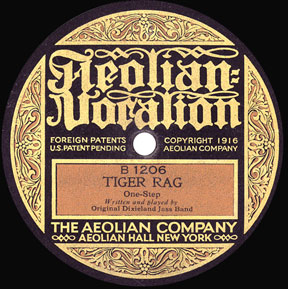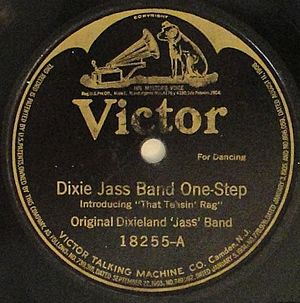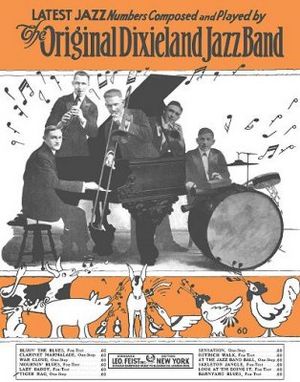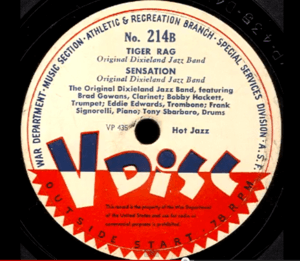Original Dixieland Jass Band facts for kids
Quick facts for kids
Original Dixieland Jass Band
|
|
|---|---|
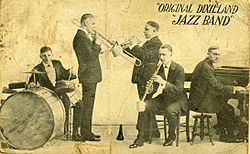
1918 promotional postcard of the ODJB showing (from left), drummer Tony Sbarbaro (aka Tony Spargo), trombonist Edwin "Daddy" Edwards, cornetist Dominick James "Nick" LaRocca, clarinetist Larry Shields, and pianist Henry Ragas
|
|
| Background information | |
| Origin | New Orleans, Louisiana |
| Genres | Jazz |
| Years active | 1916–1925, 1936–1938 |
| Past members |
|
The Original Dixieland Jass Band (ODJB) was a famous Dixieland jazz band. They made the very first jazz recordings in early 1917. Their song "Livery Stable Blues" was the first jazz record ever released. The group created and recorded many popular jazz standards. Their most famous song was "Tiger Rag". In late 1917, the band changed the spelling of their name to Original Dixieland Jazz Band.
The band had five musicians. They had all played in bands led by Papa Jack Laine before. ODJB called themselves the "Creators of Jazz." They were the first band to record jazz music for sale. They also had the first hit songs in the jazz style. The band leader and cornet player, Nick LaRocca, believed his band deserved credit. He said they were the first to record jazz and make it a popular type of music.
Contents
How the Band Started
In 1916, a music promoter from Chicago wanted to bring a New Orleans-style band to his city. He asked clarinet player Alcide Nunez and drummer Johnny Stein. They put together a band with trombonist Eddie Edwards, pianist Henry Ragas, and cornet player Frank Christian. Just before they left, Christian decided not to go. So, Nick LaRocca joined the band at the last minute.
On March 3, 1916, the band started playing at Schiller's Cafe in Chicago. They were called Stein's Dixie Jass Band. The band was a big hit! They got offers for more money from other places. Since only Stein was officially hired, the rest of the band left. They brought in drummer Tony Sbarbaro from New Orleans. On June 5, they started playing as The Dixie Jass Band.
LaRocca and Nunez did not get along well. So, on October 30, they swapped clarinet players with another band. This brought Larry Shields into the Original Dixieland Jass Band. A talent agent named Max Hart noticed the band. He booked them to play in New York City. In early 1917, the band started playing for dances at Reisenweber's Cafe in Manhattan.
First Jazz Recordings
Other New Orleans bands had visited New York City before. But they were usually part of vaudeville shows. ODJB, however, played for dancing. This helped them gain many fans in New York. They recorded their music at a time when most recording companies were in New York City and Camden, New Jersey.
Soon after arriving in New York, the band got an offer. On January 29, 1917, Columbia Graphophone Company asked them to audition. The audition happened on January 31, 1917. But none of these first recordings were ever released.
Next, the band recorded two songs for the Victor Talking Machine Company. These songs were "Livery Stable Blues" and "Dixieland Jass Band One-Step". They recorded them on February 26, 1917, at Victor's New York studios. These songs were released in May 1917 as Victor 18255. This was the first jazz record ever released!
The band's recordings were a big surprise hit. They gave many Americans their first chance to hear jazz music. Another musician, Joe Jordan, sued the band. He said that "One Step" used parts of his 1909 ragtime song "That Teasin' Rag." So, the record labels were changed to mention Joe Jordan. There was also a court case about who wrote "Livery Stable Blues." The judge decided that the song was "public domain," meaning anyone could use it.
After their success with Victor, ODJB went back to Columbia in May. They recorded two popular songs chosen by the record company. These were "Darktown Strutters' Ball" and "(Back Home Again in) Indiana".
Many new jazz bands started because of ODJB's success. These bands tried to copy ODJB's style and sound. Other bands, like Wilbur Sweatman's, also started calling themselves "jass" or "jazz" bands.
Sicilian Roots
Both Nick LaRocca and Tony Sbarbaro had parents who came from Sicily, an island in Italy. The capital of Sicily, Palermo, had a long history of trading cotton and citrus fruits with New Orleans. This led to a direct shipping route between the two cities. Because of this, many Sicilians moved to New Orleans and other American cities in the late 1800s and early 1900s. They brought Sicilian sounds with them. These sounds mixed with the local African-American music in New Orleans. The band used this mix of sounds in their music.
Later Years of the Band
After their first recordings, ODJB continued to record for other companies. They were very popular in New York. In 1918, trombonist Eddie Edwards joined the army for World War I. Emile Christian replaced him. The next year, pianist Henry Ragas died from the 1918 flu pandemic. He was replaced by pianist and composer J. Russel Robinson.
J. Russel Robinson wrote many famous jazz songs. Some of his well-known songs include "Eccentric," "Margie," and "Singin' the Blues." Many famous musicians like Bix Beiderbecke and Cab Calloway recorded his songs. Robinson's songs "Margie" and "Palesteena (Lena from Palesteena)" were huge hits in 1920. He was part of the band until it broke up in 1923. He rejoined when the band got back together in 1936.
The song "Margie" has been recorded over a hundred times! Famous artists like Louis Armstrong, Ray Charles, and Duke Ellington have covered it. "Margie" was a top 10 hit for ODJB in 1921.
London Tour
Other New Orleans musicians, like Alcide Nunez, also went to New York. This gave ODJB more competition. So, LaRocca decided to take the band to London. There, they would be the only real New Orleans jazz band. They could again say they were the "Originators of Jazz." This was because they were the first to record this new type of music.
On April 7, 1919, the band played in a show called Joy Bells in London. This was the first official live jazz performance in the United Kingdom. Later, they even performed for King George V at Buckingham Palace. At first, the audience seemed confused. But then the King laughed and clapped loudly for their song "The Tiger Rag." After that, the audience enjoyed the show.
The band returned to the United States in July 1920. They toured for four more years. This version of the band played in a more popular style. They even added a saxophone to their music.
Band Breaks Up and Reunites
The band broke up in the late 1920s. The original members went their separate ways. During the Great Depression, trombonist Eddie Edwards was found working at a newsstand. News stories about him led to Edwards leading a band at a nightclub.
In 1936, the musicians played a reunion show on the radio. Victor Records invited them back to the recording studio. Over the next two years, the band recorded 25 songs. They were called "The Original Dixieland Five." The group toured for a short time before breaking up again. Clarinet player Larry Shields got a lot of praise on this tour. Famous musician Benny Goodman said Shields was an important early influence on him.
Later, in the 1940s and 1950s, Eddie Edwards and Tony Sbarbaro formed bands using the ODJB name. Nick LaRocca's son, Jimmy LaRocca, still leads bands today called The Original Dixieland Jazz Band.
Their Influence on Music
ODJB was the first band to successfully record jazz. They helped create and establish jazz as a new type of music. Famous cornet player Bix Beiderbecke was inspired by ODJB to become a jazz musician. He was very influenced by Nick LaRocca's playing style.
Louis Armstrong, another jazz legend, recognized how important ODJB was. He said:
Only four years before I learned to play the trumpet in the Waif's Home, or in 1909, the first great jazz orchestra was formed in New Orleans by a cornet player named Dominick James LaRocca. They called him 'Nick' LaRocca. His orchestra had only five pieces but they were the hottest five pieces that had ever been known before. LaRocca named this band 'The Old Dixieland Jass Band'. He had an instrumentation different from anything before, an instrumentation that made the old songs sound new. Besides himself at the cornet, LaRocca had Larry Shields, clarinet, Eddie Edwards, trombone, Ragas, piano, and Sbarbaro, drums. They all came to be famous players and the Dixieland Band has gone down now in musical history.
Film Appearances
In 1917, the band made the first appearance of a jazz band in a movie. It was a silent movie called The Good for Nothing. Nick LaRocca, Larry Shields, Tony Sbarbaro, and Henry Ragas appeared in the film as a band.
Nick LaRocca and the reunited Original Dixieland Jass Band also performed "Tiger Rag" in a newsreel. It was called "Birth of Swing" and was released in theaters in 1937.
The Music of ODJB
"Tiger Rag"
The band's 1917 song "Tiger Rag" became one of the most popular jazz standards. By 1942, there were 136 different versions of "Tiger Rag" recorded by other artists. It has been a classic ever since.
Their first release, "Livery Stable Blues", featured instruments making barnyard animal sounds. They also used a full trap set, wood blocks, cowbells, and gongs. These sounds were new and exciting in music. Their music was very lively compared to other popular music of the time.
Many songs first written and recorded by the Original Dixieland Jass Band are still played today. These include "Tiger Rag," "Margie," "Clarinet Marmalade," and "At The Jazz Band Ball." These songs are still popular with Dixieland and traditional jazz bands.
The Original Dixieland Jazz Band's recording of "Tiger Rag" was the number one song for two weeks in December 1918. The Mills Brothers recorded "Tiger Rag" with lyrics in 1931. Their version was number one for four weeks.
Compared to later jazz, ODJB's recordings had less solo improvisation. Clarinet player Larry Shields was a very interesting player. His melodic ideas were copied by many musicians who came after him.
Their music was wild and energetic. This style is still known as Dixieland music today.
Famous Recordings
The band made many important recordings. Here are some of their well-known 78-rpm records:
1917–1920
- "Dixie Jass Band One-Step"/"Livery Stable Blues", 1917, Victor 18255.
- "At the Jazz Band Ball"/"Barnyard Blues", 1917, Aeolian Vocalion A1205
- "Ostrich Walk"/"Tiger Rag", 1917, Aeolian Vocalion A1206
- "Darktown Strutters' Ball"/"(Back Home Again in) Indiana", 1917, Columbia A2297. The ODJB recording of "Darktown Strutters' Ball" was honored in the Grammy Hall of Fame in 2006.
- "Skeleton Jangle"/"Tiger Rag" (1918 version), 1918, Victor 18472
- "Bluin' the Blues"/"Sensation Rag", 1918, Victor 18483
- "Mournin' Blues"/"Clarinet Marmalade", 1918, Victor 18513
- "Fidgety Feet (War Cloud)"/"Lazy Daddy", 1918, Victor 18564
- "Margie"/"Singin' the Blues"/"Palesteena", 1920, Victor 18717
1921–1946
- "Jazz Me Blues/St. Louis Blues", 1921, Victor 18772
- "Royal Garden Blues"/"Dangerous Blues", 1921, Victor 18798
- "Toddlin' Blues"/"Some of These Days", 1923, Okeh 4738
- "Original Dixieland One-Step/Barnyard Blues" (new version of "Livery Stable Blues"), 1936, Victor 25502
- "Tiger Rag" (1943 version), 1944, V-Disc 214B1. V-Discs were recordings given only to the U.S. armed forces.
- "Sensation" (1943 version), 1944, V-Disc 214B2
Honors and Awards
In 1977, the ODJB classic "Singin' the Blues" was honored. It was inducted into the Grammy Hall of Fame. This was for a famous 1927 recording by Frankie Trumbauer and His Orchestra.
On April 3, 1992, the City Council of New Orleans honored the band members. In 2003, the 1918 ODJB recording of "Tiger Rag" was added to the U.S. Library of Congress National Recording Registry. This registry saves important American sound recordings. In 2006, the Original Dixieland Jazz Band's recording of "Darktown Strutters' Ball" was also inducted into the Grammy Hall of Fame.
The Grammy Hall of Fame honors recordings that are at least 25 years old and have "qualitative or historical significance."
| Original Dixieland Jazz Band: Grammy Hall of Fame Awards | |||||
| Year Recorded | Title | Genre | Label | Year Inducted | Notes |
|---|---|---|---|---|---|
| 1917 | "Darktown Strutters' Ball" | Jazz (single) | Columbia | 2006 | |
See also
 In Spanish: Original Dixieland Jass Band para niños
In Spanish: Original Dixieland Jass Band para niños


